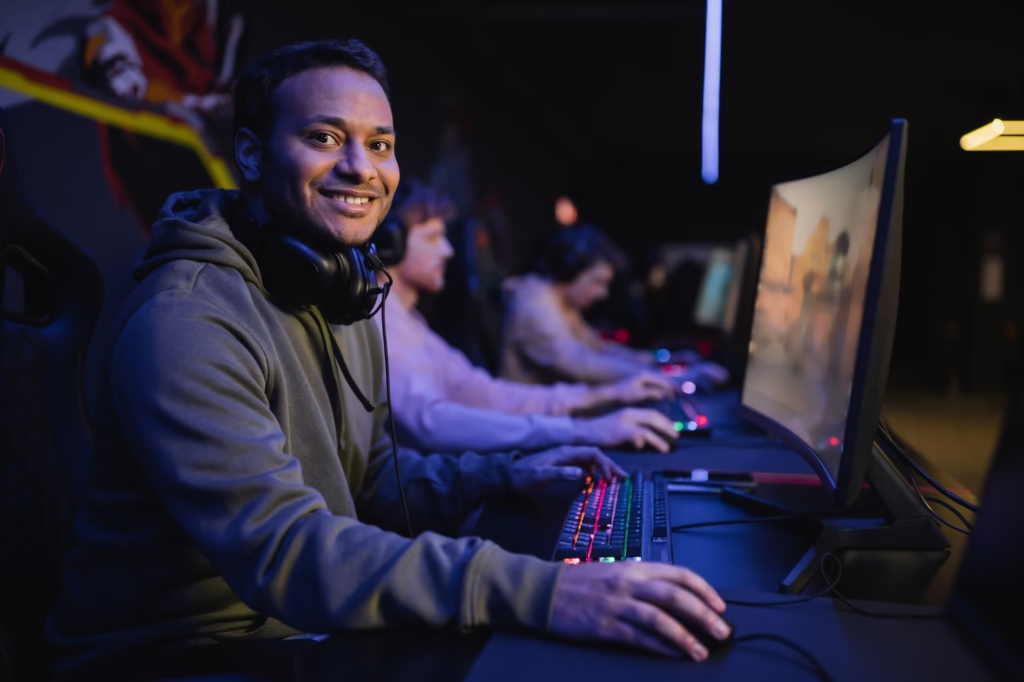Today, gaming marketing encompasses several forms, including in-game advertisements, promotional videos, and sponsored content. In-game advertisements seamlessly integrate products or brands into the gaming experience, providing a subtle yet effective form of marketing that does not disrupt gameplay. This method not only enhances brand visibility but also fosters a connection with the player, as the products become part of the virtual world they navigate. Promotional videos, on the other hand, are designed to generate excitement and anticipation for upcoming game releases. These videos are often shared across various digital platforms, increasing their reach exponentially and effectively engaging potential customers.
Another crucial aspect of gaming advertising is sponsored content, where brands collaborate with popular gamers or influencers to create engaging material that highlights their products. This strategy leverages the trust and engagement of influencers within the gaming community, allowing brands to effectively target their desired audience. In the diverse and dynamic gaming landscape of India, understanding the nuances of legal issues associated with gaming ads is essential for marketers. This recognition not only ensures compliance with regional regulations but also optimizes the effectiveness of the advertising efforts. Overall, the significance of gaming advertising extends beyond mere promotion; it serves as a bridge connecting brands with gamers in an increasingly competitive market.
The Growth of the Gaming Industry
The gaming industry has witnessed remarkable evolution, transforming from a niche pastime into a colossal multi-billion dollar market. According to various industry reports, the global gaming market was valued at approximately $159.3 billion in 2020, and projections suggest that it could exceed $200 billion by 2023. This rapid growth is fueled by the advancements in technology, increased internet accessibility, and the widespread adoption of mobile devices, allowing a greater number of consumers to engage with gaming content. As a result, the number of gamers worldwide has soared, with estimates showing over 3 billion active players globally.
The diversification of gaming platforms has significantly contributed to this growth. Consoles, PC gaming, mobile applications, and cloud gaming services cater to varied consumer preferences, attracting a broader demographic of players. This extensive range of platforms provides marketers with innovative opportunities for gaming marketing strategies tailored to specific audiences. Additionally, the rise of eSports has further revolutionized how companies approach advertising within the gaming community, creating a new paradigm for advertisers to reach engaged, enthusiastic audiences.
In India, the gaming sector has gained traction, particularly among the youth population. The country has become a hotspot for gaming, driven by increased smartphone usage, increased internet penetration, and a burgeoning interest in competitive gaming. Indian gamers are not only consuming content but are also actively participating in game development and streaming, providing fresh opportunities for gaming marketers to engage with this dynamic audience. Countries like India are beginning to explore legal issues surrounding gaming, such as monetization and regional regulations, which could influence the strategies employed by advertisers. Therefore, as the gaming industry continues its upward trajectory, effective gaming marketing will play a crucial role in harnessing this potential while navigating the complexities of the evolving landscape.
Types of Gaming Ads
As the gaming industry continues to grow exponentially, so does the diversity of gaming marketing strategies employed by brands seeking to engage their audiences. Among the most prominent types of gaming ads, in-game advertising stands out as a method that integrates promotional content directly into a game. This form of advertising can take various forms, from billboards within game environments to branded items used by characters. One of the key benefits of in-game advertising is its ability to create an immersive experience for players, enhancing brand recall in a subtle manner. However, the challenge lies in ensuring the advertisement does not disrupt the gaming experience.
Video ads are another common format used in gaming marketing, often seen as interstitial or skippable ads. These advertisements can be strategically placed before, during, or after gameplay and are usually designed to capture the viewer’s attention quickly. While video ads have the potential to reach a wide audience effectively, they can also lead to player frustration if perceived as overly intrusive. The balance of frequency and quality is critical in this digital advertising format to maintain player satisfaction.
Influencer marketing has emerged as a formidable player in gaming ads, tapping into the credibility and relatability of popular streamers and content creators. By partnering with influencers in the gaming community, brands can engage audiences more authentically. However, this approach demands careful selection of influencers whose values align with the brand, as mismatches can lead to negative perceptions. Finally, social media campaigns serve as a crucial tool for brands, enabling them to promote games and engage with players on platforms where they spend significant time. While these campaigns can generate buzz and cultivate community, brands must navigate legal issues regarding advertising standards and audience targeting in different regions, especially in India, where regulations can impact advertising strategies.
Target Audience and Demographics
The gaming industry has experienced exponential growth over the past decade, expanding exponentially in both audience size and diversity. Understanding the demographics of the gaming audience is crucial for effective gaming marketing strategies, especially in a diverse nation like India. Key statistics reveal that gamers are not limited to a singular age group or gender, which dramatically affects advertising strategies and campaign designs.
As per recent studies, individuals aged between 18 to 34 years comprise the largest segment of gamers globally, holding a significant share in India as well. This demographic is particularly attractive for advertisers, as they often have disposable income and show a strong engagement with digital platforms. Interestingly, the age distribution continues to broaden, with a notable increase of players aged 35 and above, who engage with mobile and online games, demonstrating that the appeal of gaming extends across age boundaries.
Gender distribution within gaming also showcases intriguing patterns. Historically viewed as male-dominated, the gaming landscape is transforming, with an increasing number of female gamers in India. Recent estimates suggest that women make up nearly 40% of gamers, emphasizing the importance of inclusive gaming marketing approaches. Not only does this change necessitate focusing on diverse interests and preferences, but it also presents unique opportunities to tap into previously overlooked markets.
Geographic factors further influence gaming demographics. With urban regions contributing significantly to gaming populations, there exists a stark contrast when compared to rural engagements. Various regions in India are showing a surge of interest in mobile gaming, appealing to audiences seeking entertainment in easily accessible formats. Understanding these geographic variances ensures that gaming marketing campaigns can be localized effectively, reaching specific target audiences with tailored messages that resonate deeply.
To leverage this evolving landscape, gaming marketers must continuously adapt their strategies. By keeping abreast of demographic trends, understanding player motivations, and recognizing the diversity within gaming audiences, brands can craft impactful advertising campaigns that resonate and connect with gamers across the spectrum.
Innovative Strategies in Gaming Ads
In the rapidly evolving landscape of gaming marketing, brands have adopted various innovative strategies to effectively reach and engage gamers. Among these strategies, immersive experiences play a critical role in creating a connection between the product and the gaming community. For example, the integration of branded content within popular games can lead to a seamless advertising experience that enhances gameplay without detracting from the user experience. This not only increases brand visibility but also establishes relevancy in the gaming context.
Another noteworthy approach is the use of interactive advertisements that invite players to engage directly with the brand. Utilizing game mechanics, these ads can take the form of mini-games or challenges that incentivize participation through rewards or in-game currency. A successful example is the collaboration between a beverage company and a widely known mobile game, where players could unlock exclusive in-game items by interacting with the brand’s promotional features. This type of engagement fosters a sense of loyalty and interest, transforming the ad into an integral part of the gaming experience instead of a mere interruption.
Furthermore, the gamification of marketing strategies has emerged as a significant trend within the gaming industry. By incorporating game-like elements into advertising campaigns, brands can motivate users to interact with their products and services while enjoying an entertaining experience. For instance, loyalty programs that offer rewards akin to leveling up in a game can capture the attention of gamers and encourage repeat engagement. These innovative strategies not only enhance brand recognition but also contribute to a more dynamic and interactive marketing landscape.
In this digitally driven environment, understanding these innovative strategies is essential for effectively navigating the legal issues surrounding gaming marketing in various regions, including India. As companies adapt to continually changing consumer preferences and regulatory landscapes, embracing these creative tactics could be a pathway to success in the competitive gaming market.
Challenges and Controversies in Gaming Ads
The landscape of gaming marketing has evolved significantly, presenting numerous challenges and controversies for brands aiming to engage with audiences in this dynamic sector. One of the primary obstacles faced by marketers is ad blocking. With the rise of tools designed to eliminate intrusive advertisements, a substantial portion of the gaming community actively opts out of viewing ads altogether. This trend has prompted brands to rethink their advertising strategies, emphasizing the need for more subtle and integrated approaches that respect player preferences while still achieving visibility.
Furthermore, player fatigue poses another significant hurdle for gaming marketing. As advertisements become more prevalent and diverse within the gaming experience, players may experience an overload of promotional content. This saturation can lead to negative perceptions of both the ads and the brands behind them, ultimately diminishing the effectiveness of the marketing efforts. Understanding player sensitivities and designing engaging yet non-intrusive advertising experiences are critical for overcoming this challenge.
Regulatory issues also complicate gaming ads, particularly in the Indian market where legal frameworks are still evolving. Many jurisdictions are scrutinizing the ethical implications of targeting minors and the data privacy concerns associated with gathering user information for advertising purposes. Brands must navigate these complex legal landscapes to ensure they comply with laws while still engaging potential customers effectively. The controversies surrounding in-game advertising touch upon the broader themes of consumer protection and ethical marketing practices, making this a critical consideration for brands seeking to maintain their reputation.
In light of these myriad challenges, it is imperative for brands to adopt a thoughtful approach to gaming marketing that not only aligns with legal standards but also addresses the ethical and emotional landscape of players. Balancing these elements can enable brands to create more meaningful and lasting connections within the gaming community.
The Role of Technology in Gaming Advertising
The landscape of gaming marketing in India has undergone a dramatic transformation, strongly influenced by advancements in technology. With the rise of augmented reality (AR) and virtual reality (VR), brands have created immersive experiences that allow gamers to engage with products in innovative ways. These technologies enable dynamic interactions, making advertisements more impactful and memorable, thus reshaping traditional marketing strategies within the gaming industry.
Moreover, programmatic advertising has revolutionized how gaming marketers allocate their resources. This automated approach allows brands to target specific demographics with precision, delivering personalized ads to users based on their gaming behavior and preferences. In India, where the gaming community is rapidly expanding, utilizing data-driven strategies enhances the relevance and effectiveness of gaming marketing initiatives. Marketers can optimize their campaigns through real-time data analytics, significantly improving their ability to measure ad performance and return on investment.
Data analytics also play a critical role in understanding audience behavior within the gaming landscape. By analyzing player engagement metrics and interactions with ads, companies can identify trends that inform their marketing strategies. This insight enables advertisers to tailor their messaging, ensuring it resonates with target demographics, thereby increasing the likelihood of conversions. With a thriving gaming culture in India, the need for effective narrative crafting in advertisements has never been more important, as businesses seek to foster deeper connections with gamers.
As technology continues to evolve, the future of gaming advertising appears promising. Innovations in AI-driven analytics and the integration of gaming experiences with other platforms will only enhance the effectiveness of advertising strategies. Brands willing to adapt to these changes will not only stand out in the competitive market but also engage with audiences in compelling and meaningful ways.
The Future of Gaming Advertising
The landscape of gaming marketing is undergoing a transformative phase, fostering new opportunities and methodologies in advertising. As technology continues to advance, several future trends are emerging that will define how advertising will evolve within the gaming industry. Central to these predictions is the anticipated evolution of ad formats, which are likely to become more immersive and interactive. By creating content that seamlessly integrates with gameplay, advertisers can facilitate a more engaging experience, drawing in players rather than disrupting their gaming sessions.
Personalization will also play a significant role in the future of gaming advertising. With increasing amounts of data being collected, marketers will be able to tailor ads to the specific preferences and behaviors of users. Such a targeted approach can lead to more effective campaigns, as players respond better to content that resonates with their individual tastes. This level of customization not only enhances the user experience but also drives higher conversion rates for advertisers, solidifying the importance of personalized gaming ads in the marketing landscape.
Another influential factor will be the integration of artificial intelligence (AI) in gaming marketing strategies. AI can analyze player data to predict trends, monitor engagement levels, and optimize ad delivery for maximum impact. Moreover, AI-driven algorithms can adjust in real-time based on player interactions, ensuring that advertisements are relevant and timely. This not only adds a layer of sophistication to marketing efforts but also helps maintain a positive player experience by avoiding repetitive or irrelevant ads.
Lastly, the emergence of new gaming platforms and technologies, such as virtual reality (VR) and augmented reality (AR), will further shift advertising strategies. These platforms offer dynamic environments where brands can engage with audiences in innovative ways, creating memorable interactions that enhance brand recall. As the gaming ecosystem continues to expand, advertisers will need to remain agile and adapt their strategies accordingly to capture the evolving preferences of gamers in India and across the globe.
Conclusion
The evolution of gaming advertising reflects a complex interplay between digital technology, creative expression, and consumer engagement. As gaming has surged in popularity across India and beyond, brands have recognized the immense potential of gaming marketing to reach targeted audiences in innovative ways. The transition from traditional advertising to more immersive formats, such as in-game ads and experiential marketing, has enabled brands to integrate their messaging seamlessly within gaming environments, fostering a deeper connection with players.
Furthermore, the legal issues surrounding gaming marketing in various jurisdictions, particularly in India, call for a careful approach. Regulators are increasingly scrutinizing how advertising is embedded within games, especially concerning issues like data privacy, age appropriateness, and responsible messaging. This regulatory landscape necessitates that brands remain agile, adapting their strategies to comply with local laws while still engaging effectively with gamers. Navigating these legalities will be crucial for marketers aiming to forge successful relationships with their audiences.
Moreover, effective gaming ads can not only enhance brand visibility but also contribute positively to the gaming experience itself. Innovative campaigns that resonate with players often lead to increased loyalty and advocacy, showcasing the power of authentic engagement in achieving marketing objectives. As the gaming ecosystem continues to evolve, brands must remain attentive to the needs and preferences of gamers to ensure their advertising efforts are not only effective but also beneficial to the overall gaming community.
Ultimately, the future of gaming marketing is poised for further transformation, as advancements in technology and shifts in consumer behavior will continue to shape the way brands communicate with their audiences. Hence, fostering a thoughtful approach to gaming advertising will be vital for brands looking to thrive in this dynamic landscape.








